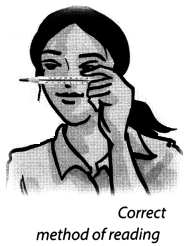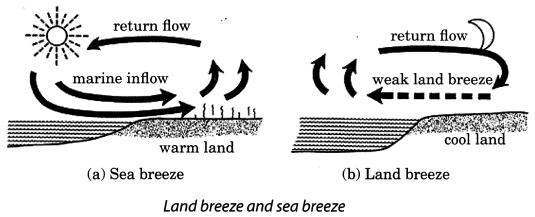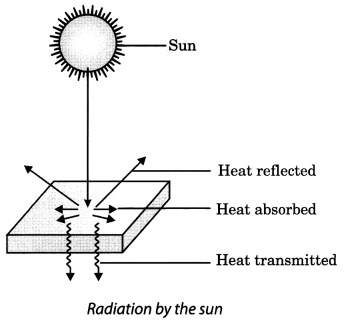In this page, we are providing Food Where Does it Come From Class 7 Extra Questions and Answers Science Chapter 4 pdf download. NCERT Extra Questions for Class 7 Science Chapter 4 Food Where Does it Come From with Answers will help to score more marks in your CBSE Board Exams.
Class 7 Science Chapter 4 Extra Questions and Answers Heat
Extra Questions for Class 7 Science Chapter 4 Heat with Answers Solutions
Heat Class 7 Extra Questions Very Short Answer Type
Question 1.
How does the transfer of heat take place in water or air?
Answer:
By the process of convection.
Question 2.
Write the range of laboratory thermometer.
Answer:
-10°C to 110°C
Question 3.
Name the process in which a solid directly changes into gas on heating.
Answer:
Sublimation
Question 4.
What is the range of a clinical thermometer?
Answer:
35°C to 42°C
Question 5.
Why do we wear woollen clothes during winter?
Answer:
The wool traps air in it which is a poor conductor of heat and hence it keeps us warm in winter.
Question 6.
Name the scales used to measure body temperature in humans.
Answer:
Celsius and Fahrenheit
Question 7.
Give any two examples of good conductors of heat.
Answer:
Silver, iron
Question 8.
Give an example of insulator.
Answer:
Plastic
Question 9.
Which physical state of matter expands the most on heating?
Answer:
Gas
Question 10.
What is the SI unit of temperature?
Answer:
Kelvin (K)
Question 11.
What are the various methods of transfer of heat?
Answer:
- Conduction
- Convection
- Radiation
Question 12.
Define conductor.
Answer:
A substance that readily conducts electricity or heat is called conductor.
Question 13.
Define insulator.
Answer:
A substance with negligible electrical or thermal conductivity is called an insulator.
Question 14.
What type of clothes should we wear in the summer?
Answer:
Light-coloured cotton clothes.
Question 15.
Define heat.
Answer:
Heat is a form of energy that is transferred by a difference in temperature between one object to another.
Heat Class 7 Extra Questions Short Answer Type
Question 1.
Define sea breeze.
Answer:
Sea breeze is the movement of air from the sea towards the land in coastal areas during day time. It is a cooling breeze.
Question 2.
Define land breeze.
Answer:
Land breeze is the movement of cool air from the land towards the sea in coastal areas during night.
Question 3.
State the effects of heat.
Answer:
Heat can bring many changes in an object. An object might expand on heating, as it becomes hotter. Heat can also cause a change in the state of a body. For example, on heating, ice(solid), eventually changes into water (liquid). Heat can burn an object or even kill harmful bacteria. It can also increase the speed of chemical reactions.
Question 4.
Write about clinical thermometer.
Answer:
A thermometer specifically designed for the measurement of the temperature of our body is called a clinical thermometer. It consists of a long, narrow glass tube. It has a bulb at one end, which contains mercury. It reads temperature from 35°C to 42°C.
Question 5.
What is laboratory thermometer?
Answer:
The thermometer which is used to measure the temperature of objects in laboratory is called a laboratory thermometer. Its range is -10°C to 110°C.
Question 6.
What are the differences between temperature and heat?
Answer:
| Temperature | Heat |
| (i) It is proportional to average kinetic energy of the molecules of the body. | (i) It is total amount of internal energy of the molecules of a body. |
| (ii) As a result of heat exchange between two bodies, sum of their temperature before and after exchange is not same. | (ii) As a result of heat exchange between two bodies, total amount of heat of two bodies remains unchanged. |
| (iii) It is the effect. | (iii) It is the cause. |
| (iv) Its SI unit is Kelvin (K). | (iv) Its SI unit is Joule (J). |
Question 7.
Write any three precautions to be taken while reading a clinical thermometer.
Answer:
- Do not hold the thermometer by the bulb.
- Read the thermometer keeping the level of mercury along the line of sight.
- Ensure that before use the mercury level is below 35°C.
Question 8.
Can a clinical thermometer be used to measure the temperature of boiling water?
Answer:
No, a clinical thermometer cannot be used to measure the temperature of boiling water because the temperature of boiling water is more than the fixed range of the clinical thermometer, i.e., 42°C. If we try to measure the temperature of boiling water, it will break down.
Question 9.
Explain how the temperature of water can be measured by using a laboratory thermometer.
Answer:
To measure the temperature of water by using a laboratory thermometer, we follow the following steps:
- Take water in a beaker.
- Dip the laboratory thermometer in the water so that its bulb gets completely immersed in it, but make sure the bulb doesn’t touch the bottom of the beaker.
- Hold the thermometer vertically.
- Consider the movement of the thread of mercury.
- After it becomes static, notice the reading.
Question 10.
Why is the handle of a metallic kettle covered with strips of cane?
Answer:
It is because when the kettle is heated the heat does not pass through strips of cane as these are bad conductors of heat and we can hold the handle barehanded.
Heat Class 7 Extra Questions Long Answer Type
Question 1.
What is temperature? Describe two types of thermometers used to measure the temperature.
Answer:
A reliable measure of the hotness of an object is called its temperature. It is measured by a device called thermometer.
There are two types of thermometer:
(i) Clinical thermometer: The thermometer that measures the temperature of our body is called clinical thermometer (Fig. 4.15). It consists of a long, narrow, uniform glass tube. It has a bulb at one end which contains mercury. Outside the bulb a small shining thread of mercury can be seen. There is also a scale on the thermometer. The scale used in it is the celsius scale, indicated by °C. A clinical thermometer reads temperature from 35°C to 42°C.

(ii) Laboratory thermometer: This type of thermometer is used to measure the temperature of different objects in laboratories. It is made of a thin glass tube sealed at one end and a bulb with mercury at the other end. The portion of the capillary tube above the bulb is graduated in degrees usually from -10°C to 110°C.

Question 2.
How is a thermometer read? What are the precautions to be observed while reading a clinical thermometer?
Answer:
First, note the difference of temperature indicated between the two bigger marks. Also note down the number of divisions (shown by smaller marks) between these marks. Suppose the bigger marks read one degree and there are five divisions between them. Then one small division can read \(\frac {1}{5}\) = 0.2°C.

Now wash the thermometer, preferably with an antiseptic solution. Hold it firmly and give it a few jerks to bring the level of mercury down to below 35°C. Now place the bulb of the thermometer under your tongue or armpit and take it out after one minute and note the reading. This is your body temperature. This should always be stated with its unit °C.
Some precautions one must observe while reading a clinical thermometer are:
- It should be washed before and after use, preferably with an antiseptic solution.
- It should be ensured that the mercury level is below 35°C before use.
- It should be read keeping the level of mercury along the line of sight (Fig. 4.17)
- The thermometer must be handled with care.
- It should not be held by the bulb while reading.
Question 3.
What do you mean by transfer of heat? Explain the process of transfer of heat in solids, liquids and gases.
or
What do you mean by transfer of heat? Explain the process of transfer of heat.
Answer:
Flow of heat from one object to another whether solid or liquid is called transfer of heat. Heat always flows from a body at higher temperature to another body at lower temperature. In other words, heat always flows from a hotter body to a colder. In this process, the temperature of hot body falls as it releases heat which is received by the colder body or a body having lower temperatures. Thus the temperature of the colder body or less hotter body rises. The flow of heat stops when temperature of both the bodies becomes equal.
Transfer of heat take place through conduction, convection and radiation. Conduction is the process of transfer of heat from one particle to the next particle in a solid without the particles actually moving from their position.
Convection is the process of heat transfer in which the particles change their positions by constantly moving from the hotter region to the cooler region, thus causing heat energy to flow. In convection heat travels through the liquids and gases.
Radiation is the process of heat transfer from a hot body to a colder body without any medium between the two.
Question 4.
How does the heat travel in air? Explain the sea breeze and land breeze in coastal areas in this reference.
Answer:
Heat travels in air through the process of convection. The air near the heat source gets hot and rises up. The cool air from the sides comes in to take its place. In this way the air gets heated up.

In the coastal areas, people experience an interesting phenomenon. The land gets heated faster than the water during the day. The air over the land becomes hotter and rises up. The cooler air from the sea rushes in towards the land to take its place. The warm air from the land moves towards the sea to complete the cycle.
The flow of cool air from the sea towards the land to replace the hot air on land, is called sea breeze. At night it is just the reverse: The water cools down more slowly than land. So the cool air from land moves toward the sea. This is called land breeze.
Question 5. Explain the term radiation.
or
Explain how can heat travel in vacuum or without medium.
Answer:
The heat from the sun cannot reach us by conduction or convection as there is no medium such as air in most part of the space between the earth and the sun. This is possible through the process of radiation. The mode of transfer of heat energy in which no medium is needed to transfer heat from a hotter body to a colder body is called radiation. It can take place whether a medium is present or not. For example, when we sit in front of a room heater we get heat by this process.
A hot utensil kept away from the flame cools down as it transfers heat to the surroundings by radiation. Our body too, gives heat to the surroundings and receives heat from it by radiation. The figure below show the radiation by the sun. It also shows that when radiation falls on an object a part of it is reflected, a part is absorbed and a part may be transmitted. (Fig. 4.19).

Question 6.
List any four effects of heat. Explain them.
Answer:
When heat energy is absorbed by a body various changes can happen. Some of them are:
- Rise in temperature: When a body absorbs heat, it gains energy. As a result of this, temperature of the body rises and body becomes hot.
- Change in state of matter: On heating, most of the substances change its state, like solid to liquid, liquid to gas, etc.
- Expansion: All state of matter i.e., solid, liquid or gas expand on heating and contract on cooling. Expansion is most in gases, less in liquids and least in solids. Expansion due to heat is known as thermal expansion.
- Combustion: On heating, some of the substance reach their ignition temperature and starts burning. So heat causes combustion.
Heat Class 7 Extra Questions HOTS
Question 1.
Why the level of mercury rises when its bulb comes in contact with a hot object?
Answer:
Mercury expands when it is heated. Hence, it rises in the capillary tube.
Question 2.
Shopkeepers selling ice blocks usually cover them with jute sacks or saw dust. Explain why.
Answer:
Jute sacks or saw dust act as insulating material and reduces melting of ice. Thus, blocks of ice are covered with jute sacks or saw dust.
Question 3.
While constructing a house in coastal area, in which direction should the windows preferably face and why?
Answer:
The windows preferably face towards the sea as sea breeze will keep the house cool in day time.
Question 4.
Why are milk vans carrying milk from the factory to the depots painted silver or white?
Answer:
Milk vans are painted silver or white because white absorbs minimum light or reflects maximum light and thus keep the milk fresh.
Question 5.
Ventilators are situated close to the ceilings and not near the floor. Why?
Answer:
Warm air being lighter rises up and cool air takes it place. This warm air finds its exit from the ventilators located close to ceilings and thus helps in circulation of fresh air.
Heat Class 7 Extra Questions Value Based (VBQs)
Question 1.
Sarika likes to have curd in her lunch. She even knows that for setting curd, a small amount of curd is added to warm milk. The microbes present in the curd help in setting the curd, if the temperature of the mixture remains approximately between 35°C to 40°C. But she is worried because it is winter and the room temperature remains much below the range which makes setting of curd difficult.
(a) Suggest a way to Sarika to set curd in such a situation.
(b) Why setting of curd during winter season become difficult?
(c) Is eating curd good for health?
(d) What value of Sarika is shown here?
Answer:
(a) Sarika can set curd by
- Keeping the container wrapped in woollen material or inside a heat resistant container.
- Keeping the container near the gas stove while cooking.
(b) In winter season temperature is very low. Low temperature inhibits the activity and growth of microbes present in curd and thus makes setting of curd difficult.
(c) Yes, as eating curd helps in digestion, boost our immunity and gives us many nutrients required for our growth.
(d) Sarika is an intelligent girl with good food habits but she lacks a little information about how insulators can help to keep things warm.
Question 2.
Ramjas lived in an old house. His father thought of reconstructing the house. He brought a new house plan design to home to show it to every family member. Ramjas pointed out that the house lack ventilators and he is unhappy for that.
(a) Are ventilators important? Why?
(b) In summer, which colour will you choose to paint outer wall of your house?
(c) What value of Ramjas is shown here?
Answer:
(a) Yes. A ventilator helps in circulating fresh and cool air from outside and taking out stale and warm air from the room. Thus, it helps in maintaining the quality of air.
(b) In summer, I would like to paint outer wall with lighter colour to reflect most of the heat and keeping house cool.
(c) Ramjas is thoughtful, intelligent, health conscious with scientific aptitude.